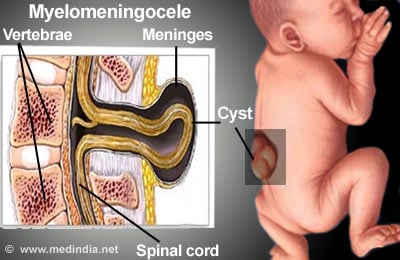- Nelson Textbook of Pediatrics. 18th ed.
- The Merck Manual
- Cohen AR, Robinson S: Myelomeningocele and myelocystocele. In Youmans Neurological surgery. Volume 2. 5th edition. Edited by Winn HR. Philadelphia: Saunders; 2003:3215-3228.
- Aubry MC, Aubry JP, Dommergues M: Sonographic prenatal diagnosis of central nervous system abnormalities.
- Child Nerv Syst 2003, 19:391-402. Publisher Full Text
- Boyd PA, Wellesley DG, De Walle HEK, Tenconi R, Garcia-Minaur S, Zandwijken GR, Stoll C, Clementi M: Evaluation of the prenatal diagnosis of neural tube defects by fetal ultrasonographic examination in different centers across Europe. J of Medical Screening 2000, 7:169-174. Publisher Full Text
About
Myelomeningocele is the most severe form of spina bifida, a birth disorder in which the backbone and spinal canal do not close before birth. Spina bifida is a common congenital anomaly.
Myelomeningocele results in protrusion of the cord and the meninges as they push through the defect in the bone of the spinal column in the back.

Meninges are the tissues covering the spinal cord. A newborn may have a sac sticking out of the mid to lower back. Some degree of paralysis can occur in a child with meningomyelocele.
This major congenital anomaly is due to a defective closure of the neural tube between the 18–25th days of gestation. There is no definitive cure for this condition that can cripple the central nervous system.
It may affect as many as 1 out of every 800 infants.
The condition can be diagnosed during prenatal screening.
Patients with this condition have a life-long disability that can involve their motor sensory, bone and urinary organs.
Despite the best treatment nearly 14% of neonates born with Myelomeningocele do not survive more than 5 years. Most have an IQ above 80 but because of the disability are unable to manage independently as adults.
Low folate levels during pregnancy increase risk of spina bifida. The exact cause is unknown. The defective closure of vertebral columns may not produce any symptoms in some children; while in others severe neurologic dysfunction may result.
At birth one may notice a bulge in the lower back or hair at the back part of the pelvis called the sacral area and dimpling of the sacral area.
Surgery is an option but there is no definitive cure for this condition.
The psychological, social and financial implications on the family is enormous. It is estimated that the care of affected individual costs about $250,000 per person per lifetime in the United States.





